Understanding Investigational New Drug Applications (INDA)
An Investigational New Drug Application (INDA) is a crucial submission to the FDA for permission to conduct clinical studies on new drug products. It plays a pivotal role in assessing the safety and efficacy of new drugs before they can be marketed and distributed for human use. This article covers the definition of an IND, the FDA's role in drug development, the importance of an INDA, scenarios where an IND is not needed, and different types of IND submissions. Understanding the process and significance of an INDA is essential for pharmaceutical companies aiming to bring new drugs to market.
Download Presentation

Please find below an Image/Link to download the presentation.
The content on the website is provided AS IS for your information and personal use only. It may not be sold, licensed, or shared on other websites without obtaining consent from the author. Download presentation by click this link. If you encounter any issues during the download, it is possible that the publisher has removed the file from their server.
E N D
Presentation Transcript
Investigational New Drug Application [INDA] 1
Introduction What is an IND ? An IND is a submission to the food and drug administration (FDA) requesting permission to initiate a clinical study of a new drug product. The Federal Food , Drug and Cosmetic act requires that marketing application before they can be shipped in interstate commerce. drugs have an approved The IND application allows a company to initiate and conduct clinical studies for their new drug products. The IND application provides the FDAwith the data necessary to decide whether the new drug and the proposed clinical trial pose a reasonable risk to the human subjects participating in the study. 2
What is an IND ? FDA's role in the development of a new drug begins when the drug's sponsor has screened the new molecule for pharmacological activity and acute toxicity potential in animals, wants to test its diagnostic or therapeutic potential in humans The molecule changes in legal status under the Federal Food, Drug, and Cosmetic Act and becomes a new drug subject to specific requirements of the drug regulatory system Drug is to be the subjected to an approved marketing application before it is transported or distributed across state lines IND- notice of claimed investigational exemption for a new drug must be filed with regulatory body. 3
Importance of INDA An IND is required any time I want to conduct a clinical trial of an unapproved drug. An IND would be required to conduct a clinical trail if the drug is a new chemical entity , not approved for the indication under investigation in a new dosage form. Being administered at a new dosage level. in combination with another drug and the combination is not approved. All clinical studies where a new drug is administered to human subjects , regardless of whether the drug will be commercially developed , require an IND. 4
When you dont need an IND An IND is not required to conduct a study if the drug : It is not intended for human subjects , but is intended for in vivo testing or lab research animals (non clinical studies). It is an approved drug and the study is within its approved indication for use. 5
TYPES OFIND InvestigatorIND o Submitted by a physician who both initiates and conducts an investigation, and under whose immediate direction the investigational drug is administered or dispensed. o Physician might submit a research IND to propose studying an unapproved drug, or an approved product for a new indication or in a new patient population Emergency Use IND o Allows FDAto authorize use of an experimental drug in an emergency situation o Does not allow time for submission of an IND in accordance with 21CFR , Sec. 312.23 or Sec. 312.34 Treatment IND o Submitted for experimental drugs showing promise in clinical testing for serious or immediately life-threatening conditions while the final clinical work is conducted and the FDAreview takes place 6
CLASSIFICATION OF IND Commercial o Permits sponsor to collect data on clinical safety and effectiveness needed for application for marketing in the form of NDA Research (non-commercial) o Permits the sponsor to use drug in research to obtain advanced scientific knowledge of new drug o No plan to market the product 7
CONTENT OF IND In three broad areas: Animal Pharmacology and Toxicology Studies o An assessment as to whether the product is reasonably safe for initial testing in humans o Any previous experience with the drug in humans Manufacturing Information o composition, manufacturer, stability, and controls used for manufacturing the drug Clinical Protocols and Investigator Information o Commitments to obtain informed consent from the research subjects, to obtain review of the study by an institutional review board (IRB), and to adhere to the investigational new drug regulations. Once the IND is submitted, the sponsor must wait 30 days before initiating any clinical trials. During this time, FDA opportunity to review the IND for safety to assure that research subjects will not be subjected to unreasonable risk has an 8
FORMAT OF INDA Cover sheet (Form FDA-1571) Name, address, telephone of sponsor Identification of phases Commitment not to begin CT until IND approval Commitment by IRB- Form 56 Commitment for conducting CT- accordance with regulations Name, title Monitor Name, title person(s) for reviewing Name, Address of CRO, if any Signature of sponsor Table of contents Introductory statement & general investigational plan Investigatorsbrochure Study protocol Investigatorfacilities & IRB data Chemistry manufacturing & control data H.Pharmacology & toxicologydata I. P 19r-e 06v-2i0o1u 6s human experience A. o o o o o o o o o B. C. D. E. F. G.
Resources For INDApplications Pre-InvestigationalNew DrugApplication (IND) Consultation Program o Offered by CDER (Center for Drug Evaluation and Research) to foster early communications between sponsors and new drug review divisions in order to provide guidance on the data necessary to warrant IND submission. Guidance Documents for INDs o documents are prepared for FDA review staff and applicants/sponsors to provide guidelines to the processing, content, and evaluation/approval of applications and also to the design, production, manufacturing, and testing of regulated products 10
GUIDANCE DOCUMENTS ForThe Complete List Of CDER Guidance, Please See The Guidance Index Safety Reporting Requirements for INDs and BE/BAStudies CGMPfor Phase 1 Investigational Drugs Exploratory IND Studies Content and Format of Investigational New Drug Applications (INDs) for Phase 1 Studies of Drugs, Including Well Characterized, Therapeutic, Biotechnology-Derived Products Q & A - Content and Format of INDs for Phase 1 Studies of Drugs, Including Well- Characterized,Therapeutic, Biotechnology-Derived Products Bioavailability and Bioequivalence Studies for OrallyAdministered Drug Products IND Exemptions for Studies of Lawfully Marketed Drug or Biological Products for the Treatment of Cancer Guideline for Drug Master Files A Drug Master File (DMF) is a submission to the Food and Drug Administration (FDA) that may be used to provide confidential detailed information about facilities, processes, or articles used in the manufacturing, processing, packaging, and storing of one or more human drugs. Required Specifications for FDA's IND, NDA, andANDADrug Master File Binders Immunotoxicology Evaluation of Investigational New Drugs 19-06-2016 SagarKishorSavale 11
Laws, regulations, Policies, Procedures The Federal Food, Drug, and Cosmetic Act is the basic food and drug law of the U.S The law is intended to assure consumers that foods are pure and wholesome, safe to eat, and produced under sanitary conditions; that drugs and devices are safe and effective for their intended uses; that cosmetics are safe and made from appropriate ingredients; and that all labeling and packaging is truthful, informative, and not deceptive. 12
Laws, regulations, Policies, Procedures Code Of Federal Regulations (CFR) o The final regulations published in the Federal Register (daily published record of proposed rules, final rules, meeting notices, etc.) are collected in the CFR. o The CFR is divided into 50 titles that represent broad areas subject to Federal regulations. o The FDA's portion of the CFR interprets the The Federal Food, Drug, and Cosmetic Act and related statutes. Section 21 of the CFR contains most regulations pertaining to food and drugs. 21CFRPart312 Investigational New Drug Application INDAand NDAApplicationsforFDA Approvalto Market a New Drug(New DrugApproval) 21CFRPart314 21CFRPart316 OrphanDrugs 21CFRPart58 Good LabPractice for NonclinicalLaboratory [Animal]Studies 21CFRPart50 Protectionof HumanSubjects 21CFRPart56 InstitutionalReviewBoards 21CFRPart201 DrugLabeling 21CFRPart54 FinancialDisclosure byClinicalInvestigators 13
Laws, regulations, Policies, Procedures CDER's Manual of Policies and Procedures (MaPPs) MaPPS are approved instructions for internal practices and procedures followed by CDER staff to help standardize the new drug review process and other activities. 14
INDAReview Process 19-06-2016 SagarKishorSavale 15
DRUG DEVELOPMENT PROCESS 19-06-2016 SagarKishorSavale 16
New Drug Development and Review Process Steps from Test Tube to New DrugApplication Review 17
Phases of clinical testing Numberof patients Length Purpose Percent successfully completing Phase Phase 1 20-100 Several months Mainlysafety 67 Phase 2 Up toseveral hundred Several months to two years Someshort- term safety but mainly effectiveness Safety, effectiveness, dosage 45 Phase 3 Several hundred toseveral thousand 1-4years 5-10 19-06-2016 SagarKishorSavale 18
Clinical Trials 10-15 years from lab to US patients Only 1 in 5000 compounds make it to human testing Only 1 in 5 tested in humans is approved Testing Phases in Humans DISCOVERY Phase I RESEARCH Phase II DEVELOPMENT Phase III CLINICALSTUDIES Phase IV MEDICINEAPPROVED 19
Introductory statement Description of the investigational drug All active ingredients Drug s pharmacological classification Structuralformula Route of administration Summary of previous human experience Formulation of dosage forms Objective and planned duration of proposed clinical investigation. 20
Investigational plan Description of clinical studies planned for the experimental drug Purpose of the study Indication to be studied Types of trials to be initiated 1.Number of study subjects 2.Risks involved 21
INVESTIGATORS BROCHURE Structural formula of drug. Summary of pharmacological , toxicological , pharmacokinetic effects in animals. Safety and efficacy Purpose of study Dose / dose frequency Monitoring procedures 22
Clinical protocol Aclinical protocol describes how a particular clinical trial is to be conducted. It describes the objectives of study the trial design how subjects are selected how the trial is to be carried out 23
It should contain the following elements: Astatement of the objective and purpose of study. Name , address and qualification of each investigator participating in the study. Name and address of each clinical site. Study subject inclusion and exclusion criteria. Estimate of the number of subjects to be enrolled in the study. 24
Chemistry, manufacturing and Control Data Determines the adequacy of methods used to manufacture and assay investigational compound Safety concerns Describe drug substances Method of preparation Reagent and solvents Acceptable limits and analytical methods to ensure quality and purity of drug. 25
Pharmacological and Toxicology data : Pharmacology and drug disposition Integrated toxicology summary Previous human exposure : Marketed (foreign) or previously tested in humans. 26
FDAReview of The INDA Once the ind is stamped as received ,it is sent to the review division within CDER. On arrival at the review division , it is critically evaluated by several reviewers of Chemisty Biopharmaceutics Medical Stastistics Microbiology Pharmacology /toxicology sections
All these areas review the data submitted with the primary purpose to ensure safety of the individual enrolled in th e study. Once an IND is submitted,the study can t be initiated until a period of 30 days. If there are any major issues relating to the safety of the volunteers in the proposed study , the FDAcan institute a clinical hold. 28
INDAAnnual reports Sponsors should submit an annual report that provides the FDAwith a brief update on the progress of all investigations included in the IND. It should contain the following: Individual study information. Summary of the study. Listing of any significant foreign marketing developments with the drug e.g. approval in another country. 29























